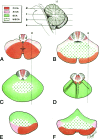Cerebellar Watershed Injury in Children
- PMID: 32327437
- PMCID: PMC7228150
- DOI: 10.3174/ajnr.A6532
Cerebellar Watershed Injury in Children
Abstract
Background and purpose: Focal signal abnormalities at the depth of the cerebellar fissures in children have recently been reported to represent a novel pattern of bottom-of-fissure dysplasia. We describe a series of patients with a similar distribution and appearance of cerebellar signal abnormality attributable to watershed injury.
Materials and methods: Twenty-three children with MR imaging findings of focal T2 prolongation in the cerebellar gray matter and immediate subjacent white matter at the depth of the fissures were included. MR imaging examinations were qualitatively analyzed for the characteristics and distribution of signal abnormality within posterior fossa structures, the presence and distribution of volume loss, the presence of abnormal contrast enhancement, and the presence and pattern of supratentorial injury.
Results: T2 prolongation was observed at the depths of the cerebellar fissures bilaterally in all 23 patients, centered at the expected location of the deep cerebellar vascular borderzone. Diffusion restriction was associated with MR imaging performed during acute injury in 13/16 patients. Five of 23 patients had prior imaging, all demonstrating a normal cerebellum. The etiology of injury was hypoxic-ischemic injury in 17/23 patients, posterior reversible encephalopathy syndrome in 3/23 patients, and indeterminate in 3/23 patients. Twenty of 23 patients demonstrated an associated classic parasagittal watershed pattern of supratentorial cortical injury. Injury in the chronic phase was associated with relatively preserved gray matter volume in 8/15 patients, closely matching the published appearance of bottom-of-fissure dysplasia.
Conclusions: In a series of patients with findings similar in appearance to the recently described bottom-of-fissure dysplasia, we have demonstrated a stereotyped pattern of injury attributable to cerebellar watershed injury.
© 2020 by American Journal of Neuroradiology.
Figures







Comment in
-
Reply.AJNR Am J Neuroradiol. 2020 Aug;41(8):E61. doi: 10.3174/ajnr.A6673. Epub 2020 Jun 25. AJNR Am J Neuroradiol. 2020. PMID: 32586961 Free PMC article. No abstract available.
-
Depth-of-Fissure Cerebellar Infarcts in Adults.AJNR Am J Neuroradiol. 2020 Aug;41(8):E60. doi: 10.3174/ajnr.A6626. Epub 2020 Jun 25. AJNR Am J Neuroradiol. 2020. PMID: 32586962 Free PMC article. No abstract available.
References
-
- Benjumea V, Vélez A, Hernández O, et al. . Infartos limítrofes cerebrales y cerebelosos asociados a compromiso hemodinámico: reporte de caso y revisión de la literature. Acta Neurol Colomb 2014;30:342–45. http://www.scielo.org.co/pdf/anco/v30n4/v30n4a16.pdf. Accessed April 6, 2020
MeSH terms
LinkOut - more resources
Full Text Sources
